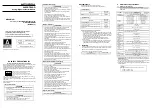
7.10 Troubleshooting Without Fault Display
SIEPCYEUOQ2V01A Q2V Technical Manual
263
Causes
Possible Solutions
The drive and motor system reached the torque limit.
•
Examine the values set in
L7-01 to L7-04 [Torque Limit]
and increase them if necessary.
Note:
If the torque limit is enabled, deceleration time can increase because the drive cannot output
more torque than the limit.
•
If
H3-02, H3-10 = 9, B, C, D [MFAI Function Select = Torque Limit]
, examine the settings for
the MFAIs.
•
Examine the values set in
H3-02 and H3-10
.
•
Use
U1-13, U1-14 [Terminal AI1 InputLv, Terminal AI2 InputLv]
to make sure that the
analog input values set to terminals A1 and A2 are applicable.
The load is more than the internal torque limit as specified by the drive rated
current.
Replace the drive with a larger capacity model.
◆
The Load Falls When a Brake Is Applied
Causes
Possible Solutions
The open/close timing of the brake is incorrect.
Refer to
“
Notes on Controlling the Brake when Using the Hoist Application Preset
”
in the
technical manual and take appropriate measures.
The DC injection braking is not sufficient.
Increase the value set in
b2-02 [DCI Braking Current]
.
◆
There Is Audible Noise from the Drive or Motor Cables When the Drive Is
Energized
Causes
Possible Solutions
The relay switching in the drive is making too much noise.
•
Use
C6-02 [Carrier Frequency Selection]
to decrease the carrier frequency.
•
Connect a noise filter to the input side of the drive power supply.
•
Connect a noise filter to the output side of the drive.
•
Isolate the control circuit wiring from the main circuit wiring.
•
Use a metal cable gland to wire the drive.
•
Shield the periphery of the drive with metal.
•
Make sure that the drive and motor are grounded correctly.
•
Make sure that ground faults have not occurred in the wiring or motor.
◆
Residual Current Monitoring/Detection (RCM/RCD) Trips During Run
Causes
Possible Solutions
There is too much leakage current from the drive.
•
Increase the RCM/RCD sensitivity or use RCM/RCD with a higher threshold.
•
Use
C6-02 [Carrier Frequency Selection]
to decrease the carrier frequency.
•
Decrease the length of the cable used between the drive and the motor.
•
Install a noise filter or AC reactor on the output side of the drive. Set
C6-02 = 1 [2.0 kHz]
when connecting an AC reactor.
•
Disable the internal EMC filter.
◆
Motor Rotation Causes Unexpected Audible Noise from Connected Machinery
Causes
Possible Solutions
The carrier frequency and the resonant frequency of the connected
machinery are the same.
•
Adjust
C6-02 to C6-05 [Carrier Frequency]
.
•
Set
C6-02 = 1 to 6 [Carrier Frequency Selection = Frequency other than Swing PWM]
.
Note:
If
C6-02 = 7 to A [Carrier Frequency Selection = Swing PWM]
, the drive will not know if
the noise comes from the drive or the machine.
The drive output frequency and the resonant frequency of the connected
machinery are the same.
•
Adjust
d3-01 to d3-04 [Jump Frequency 1 to Jump Frequency Width]
.
•
Put the motor on a rubber pad to decrease vibration.
◆
Motor Rotation Causes Oscillation or Hunting
Causes
Possible Solutions
The frequency reference is assigned to an external source, and there is
electrical interference in the signal.
Make sure that electrical interference does not have an effect on the signal lines.
•
Isolate control circuit wiring from main circuit wiring.
•
Use twisted-pair cables or shielded wiring for the control circuit.
•
Increase the value of
H3-13 [An.In FilterTime Constant]
.
The cable between the drive and motor is too long.
•
Do Auto-Tuning.
•
Make the wiring as short as possible.
The PID parameters are not sufficiently adjusted.
Adjust
[b5: PID CONTROL]
.
Summary of Contents for Q2V Series
Page 2: ...This Page Intentionally Blank 2 SIEPCYEUOQ2V01A Q2V Technical Manual...
Page 12: ...12 SIEPCYEUOQ2V01A Q2V Technical Manual...
Page 18: ...i 2 Legal Information 18 SIEPCYEUOQ2V01A Q2V Technical Manual...
Page 26: ...1 2 Features and Advantages of Control Methods 26 SIEPCYEUOQ2V01A Q2V Technical Manual...
Page 38: ...2 8 Installation Methods 38 SIEPCYEUOQ2V01A Q2V Technical Manual...
Page 70: ...3 3 Main Circuit Wiring 70 SIEPCYEUOQ2V01A Q2V Technical Manual Models B006 B012...
Page 102: ...3 17 Motor Application Precautions 102 SIEPCYEUOQ2V01A Q2V Technical Manual...
Page 138: ...4 12 Test Run Checklist 138 SIEPCYEUOQ2V01A Q2V Technical Manual...
Page 144: ...5 2 European Standards 144 SIEPCYEUOQ2V01A Q2V Technical Manual...
Page 145: ...Standards Compliance 5 5 2 European Standards SIEPCYEUOQ2V01A Q2V Technical Manual 145...
Page 146: ...5 2 European Standards 146 SIEPCYEUOQ2V01A Q2V Technical Manual...
Page 266: ...7 10 Troubleshooting Without Fault Display 266 SIEPCYEUOQ2V01A Q2V Technical Manual...
Page 284: ...8 6 Storage Guidelines 284 SIEPCYEUOQ2V01A Q2V Technical Manual...
Page 312: ...10 10 Peripheral Devices and Options 312 SIEPCYEUOQ2V01A Q2V Technical Manual...
Page 430: ...11 21 Parameters Changed by PM Motor Code Selection 430 SIEPCYEUOQ2V01A Q2V Technical Manual...
Page 731: ...SIEPCYEUOQ2V01A Q2V Technical Manual 731 Z Z pulse Auto Tuning 125...
















































